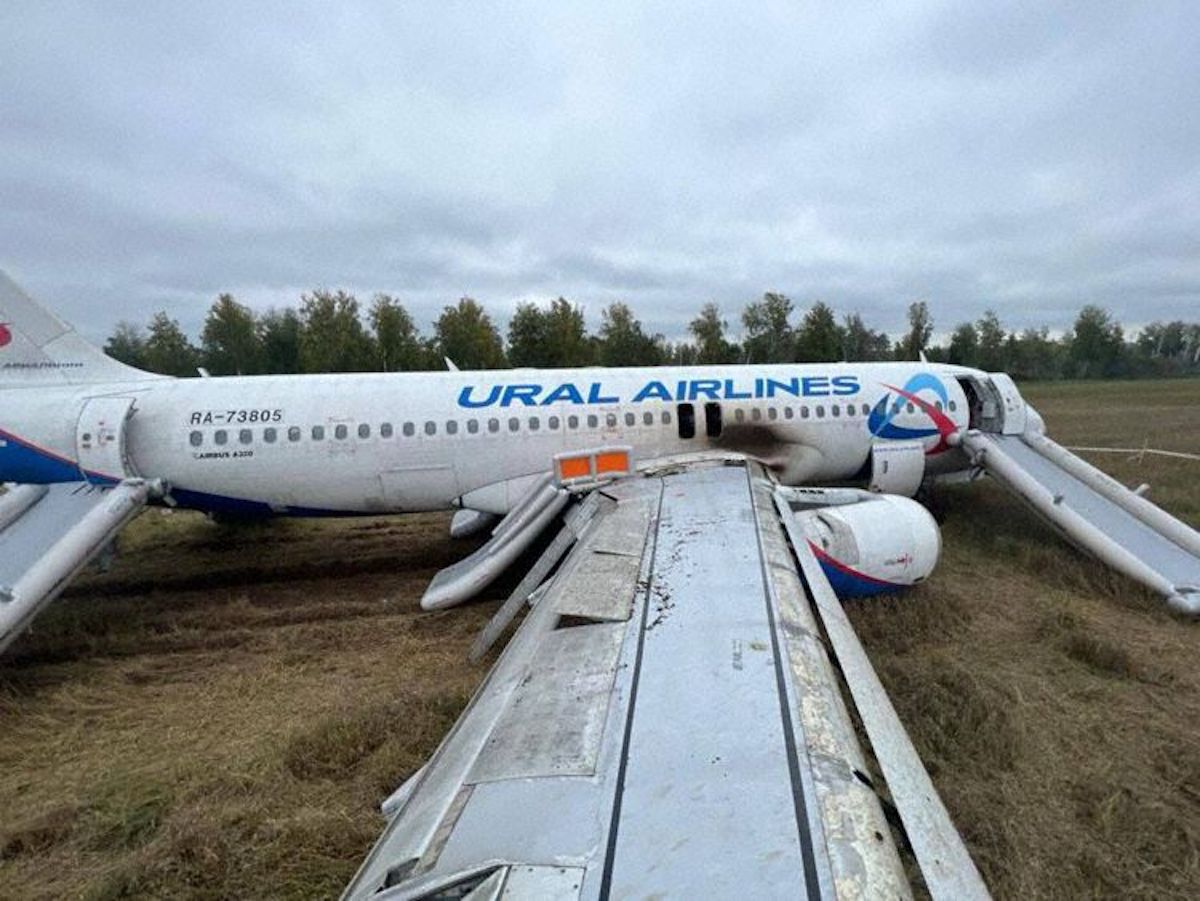
A very rare event has occurred in Russia with the successful off-field crash landing of a Ural Airlines Airbus A320. Ironically It was the same airline that became somewhat famous in 2019 when one of their other A320s suffered a dual engine failure as a result of bird strikes and was landed successfully gear up in a field.
Pilot Analysis Of Ural Airlines A320 Crash
The flight in question was Ural Airlines flight U61383 from Sochi (AER) to Omsk (OMS) which, according to reports, suffered a failure of the green hydraulic system while on approach to Omsk. The crew conducted a missed approach at Omsk and elected to continue to Novosibirsk because it has a longer runway than the one available at Omsk which is 2,500 meters or 8,202 feet long. By contrast, the runways at Novosibirsk are 3,600 meters or 11,800 feet long. The two airports are 321 nautical miles apart.
According to the news reports filtering out of Russia, the captain feared that he would run out of fuel before reaching the airport at Novosibirsk and elected to land in a field. Most remarkably, the aircraft landing gear remained intact and did not collapse during this off-field landing.
How It Happened
Let’s review how a green system hydraulic failure would impact an A320. I don’t want to go too deep into the weeds here so I am going to review only the essential impacts. I’m going to do so using the green system loss of fluid checklist as this seems closest to what is being reported.
Loss of the green system would (among other things) mean the loss of:
- powered gear extension
- two spoilers
- normal braking
- nosewheel steering
- one thrust reverser
Of all of those the biggest is the requirement to manually extend the gear which means that once it goes down it cannot be retracted. Also, the gear doors will remain open which will result in dramatically increasing the drag and thus fuel consumption. The QRH or Quick Reference Handbook, which is the checklist that would be used by the crew to address this malfunction, also contains a landing distance calculation for this failure given certain baseline conditions. Those baseline assumptions presume a number of parameters most of which are very conservative. For example, no thrust reverse is assumed, no tailwind (but equally no headwind credit) an elevation of 2,500 feet or lower and a temperature under 35ºC. The chart tells us that an A320 at maximum landing weight (142,200 pounds) on a wet runway should be able to stop in under 7,770 feet in these conditions. Or under 7,640 feet on a dry runway at 170,000 pounds, which is nearly the maximum takeoff weight.
There is another key message that will appear after the gravity extension of the gear is complete and that’s “FUEL CONSUMPT INCRSD FMS PRED UNRELIABLE.” What the system is telling us here is that given the fact the gear doors are stuck open, the aircraft is going to be burning more fuel as a result of the increased drag. Most critically the FMS, which is essentially the aircraft navigation computer, isn’t going to give you reliable data as to your estimated fuel at landing. This means if you load up a divert to another field with the gear down and the system tells you that you will land with 5000 lbs of fuel onboard (to invent a number for the purposes of illustration) it is going to be wrong.
Instead, you will land with less. Potentially a lot less.
The QRH directs us to another manual which contains performance charts for the aircraft with the gear down. Crucially (at least in my airlines’ manuals) these charts do not seem to apply to flights with the gear down but doors open. This means that these numbers are going to be optimistic, perhaps significantly so.
Looking at the charts for the A320, it is impossible to say exactly what the flight in question fuel burn would have been as there are many factors we don’t know. But just for some context around it at a weight of 135,000 pounds and a cruise altitude of FL200 (the aircraft actually flew at FL180 or 18,000 feet) you are looking at a true airspeed of 307 knots and a burn of 4310 pounds per hour.
Given that the airports are 321 nautical miles apart, you are looking at around an hour of flight in calm winds to get between them in this situation. You’re going to burn extra fuel climbing up to FL180 but will use less when descending.
According to one flight tracking sight Flight U61383 / SVR1383 – Ural Airlines – RadarBox Flight Tracker the crew reached 18,000 ft at 0204 still fairly close to Omsk. ADSB continues to track them until 0213 at 260 knots at which point, we lose track until 0240, when we pick them up again now descending through 15,400 ft having obviously decided they cannot make the runway. That period from 0204 to 0213 was more than enough time to manually estimate their fuel consumption and should certainly have told them they would come up short.
What This All Means
Ok, I’ve just dumped a lot of numbers on you and by now your head is likely spinning so let’s condense this down. The runway at the destination was long enough to land safely even with the failure. Especially given that the landing distance numbers I cite above are extremely conservative. That being said the decision to divert to a longer runway is a prudent one IF you have the gas to do so.
The crew once they decided to divert had enough time to compare their actual fuel burn at cruise altitude with the predicted numbers they should have referenced. They should have been able well before they got too far from Omsk to calculate their fuel consumption and make some back-of-the-envelope estimates as to how much they would land with. The QRH and the aircraft itself would have warned them that the FMS predictions for fuel burn could not be trusted. And those back-of-the-envelope calculations should have told them that they were not going to make it to Novosibirsk. Remember they came up 96 nautical miles short in a 321 nautical mile diversion. That they landed 96 nautical miles short of their intended divert point tells me that they were not doing the calculations they should have been.
Other Factors At Play
To be fair at this early stage there is much we do not know. For example, how many other systems on this aircraft were inoperative given the state of sanctions on Russian Aviation? Did the crew rely on the chart in the manual not realizing that they were perhaps hopelessly optimistic? That is potentially a key issue here. The QRH directs you to reference a chart that is not in fact applicable to the aircraft configuration you are flying. Your configuration with the gear doors open is a lot worse. But you have to look very closely to discover this and in the heat of the moment dealing with a broken airplane looking at a chart you’ve never seen before it would be a very easy mistake to make.
That we are forced to continue flying aircraft with emergency checklists that can be flat-out wrong is an issue. It is one the NTSB identified after USAir 1549 when first officer Jeffrey Skiles had to use a dual engine failure checklist that was never intended for a low altitude situation. The NTSB identified this in its report and made a specific recommendation that it be fixed (A-10-66) which they then marked “Closed – Acceptable Alternate Action” because the FAA said these events are too rare to warrant fixing. What’s interesting is that recommendation A-10-68 which called for training on this scenario was marked “Closed – Unacceptable Action” because A-10-66 had not been implemented. What all of this points to yet again is the utterly critical need for pilots to be taught and learn to apply airmanship as I’ve discussed in the past.
> Read More:Airmanship: What Pilots Need Most
Questions?
If you have questions about flying or airline operations you can email me at ask121pilot@yahoo.com. I will then respond in my Ask Your Captain column. If you have questions or comments about this specific story, please leave a comment below.




The headline of this post is confusing, due to different uses of the word(s) analyze/analysis and different definitions of the word “pilot”.
“Pilot analyzes” (as in the headline) implies that (at least some of) it is authored by an aircraft pilot as in “a person who flies or is qualified to fly an aircraft or spacecraft.”
“Pilot analysis” could imply the exact same thing OR it could imply a preliminary evaluation as in “serving as a guiding or tracing device, an activating or auxiliary unit, or a trial apparatus or operation.”
There’s no indication it was written by a pilot and there are no quotation marks, thus the confusion about the headline. There are lots of details which implies it’s authored by a professional pilot or aviation accident investigator. No disrespect intended but a crash analysis authored by a pilot (hopefully vastly experienced with some crash analysis experience) or crash investigator is significantly different from that authored by an non-flying Air Force veteran/attorney/professional traveler/blogger (with an amazing accommodating wife and adorable children). Not sure if the confusion is intentional or accidental.
Please clarify.
(I see now as I post this comment that that the byline includes “121PILOT”, the “Questions” include “If you have questions about flying or airline operations you can email me at ask121pilot@yahoo.com.” and “About Author” includes “121pilot is a pilot for a major U.S. commercial airline …” Posting the comment regardless just in case anyone else had the same (initial) confusion.)
It is written by a commercial airline pilot who flies for a major US carrier.
A landing with no injuries and everyone walking away is akways a good landing . Happy to see .
Very interesting. I’d like to see more of 121Pilot on here. I like to learn about the technical aspects of flying.
Feel free to suggest some things you’d be interested in having me write about. It’s difficult to judge sometimes what will be of interest and what won’t.
Thanks for your article. I agree 100% with you. I have been flying the A320 since 32 years ago and I can tell you that your article is EXCELLENT.
Greetings from Mexico City.
Ivan no can fly and conduct ‘special military operation’ at same time, while also drinking voodka.